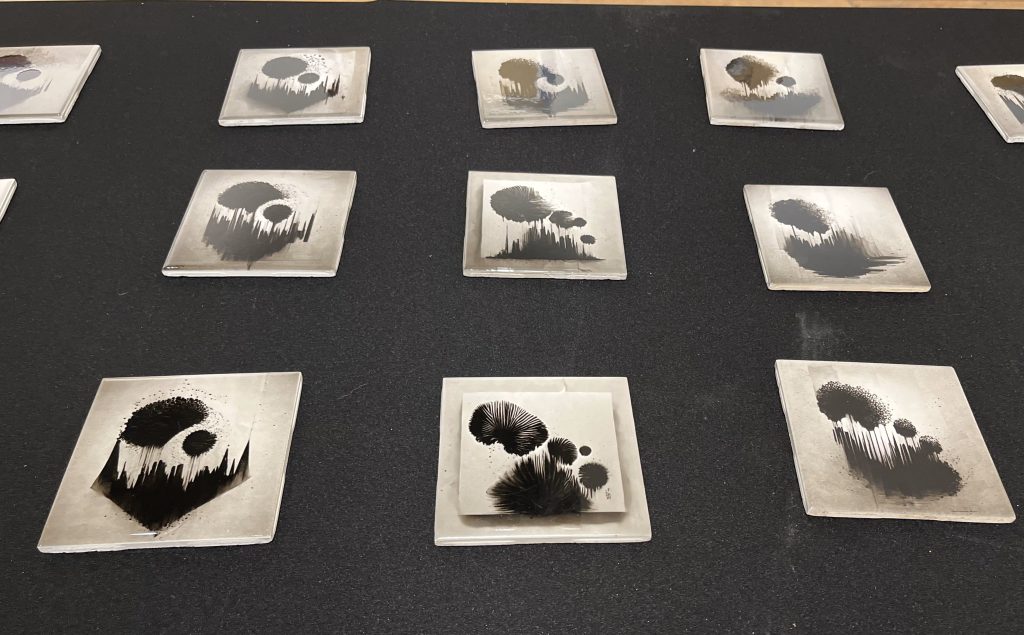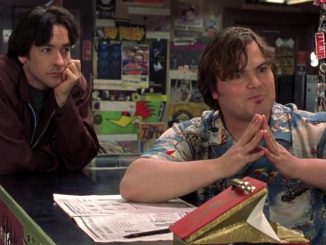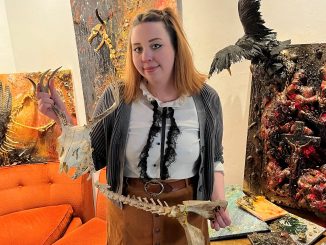![11scene2-Erin[option1]](https://chico.newsreview.com/wp-content/uploads/2023/05/11scene2-Erinoption1-1-678x381.jpg)
At first glance, the rows of square, ceramic tiles laid out across two tables inside Idea fab Labs (IFL) look fairly similar: saturated, black-and-white designs vaguely resembling asymmetrical Rorschach images. A closer look, however, revealed much more—dozens of unique images, each remarkable both for their similarities as well as their differences.
That dichotomy—uniform, yet unique—is a central theme of artist Erin Banwell’s latest work, Tree With City in the Distance: Evolution of an AI Sketch. It is Banwell’s first foray into creating art using artificial intelligence (AI), based on a whim that became a short-term obsession. The exhibit will be held at IFL, the maker space that Banwell owns and co-founded.
It started with a simple prompt typed into an AI imaging program to create the titular image—a sketch-like, abstract image that can reasonably be interpreted as a lone tree in the foreground of a faraway cityscape. Then, he used that image to create four more slight variations, and those to create four more. At some point he stepped in, and began choosing which pieces from each generation would propagate, and which would go the way of the dodo bird. In all, the process was repeated for 100-plus generations.
“There’s many different ways you can interact with any of these AI programs, and the way I chose to do so for this project is this evolutionary process.” he said. “Each image has offspring with genetic mutations, and I’d pick the ones that I wanted to go again. As the force of nature that decides what animals reproduce in the analogy of evolution, my artistic choice was the decider of what would reproduce and which lineage would die off.”

After hundreds of iterations pushed through his computer during an estimated 48 hours of near-straight work (“It felt like one sitting … I stopped to sleep now and then, but that’s pretty much it.”), Banwell said that a number of distinct series and lineages took form. Early on, in some of the images, one tree became two trees. Some he described as having a three-dimensional feel, “like a picture of a picture on a wall,” while others began to have a fabric-like appearance. Some of the fabric-like images then morphed into what Banwell described as flowers. In another lineage, a yin-yang shape formed, while others developed sharp, pointy edges.
Banwell chose 500 of his favorites, and at the time of the interview was printing the images to tiles for the May exhibition. “Just hanging the show will be really interesting and a massive undertaking,” he said. “I want to follow these lines of evolution in a way that visually speaks to people, so they can see and take in the process of evolution happening over the whole thing.”
To this end, he’s printing most of them on 4-by-4-inch tiles, with prime examples of each family group printed on 12-by-12-inch tiles. He intends to hang them in clusters, with evolutionary links between. Each of the individual tiles, numbered according to its initial order of creation, will be for sale.
The show’s opening reception on May 7 will coincide with the inaugural Orange Street Block Party (see info box). The event is hosted by IFL offshoot Maker Radio 94.5 FM in cooperation with other art-oriented establishments in the neighborhood: IFL, Orange Street Consignment, Sparkle Enterprises, Mains’l and Chico Art Center. A section of the street will be closed for the free, all-ages event and there will be food trucks, live music, other art on display, a yart sale, and children’s activities hosted by Chico Children’s Museum.
The role of AI
Banwell’s exhibit comes at a crucial time, as the rapidly expanding capability and accessibility of powerful AI programs fuels controversy about how the technology will affect everything from individual industries to society as a whole.
While many creatives are growing increasingly concerned about how AI is impacting their livelihoods, some speculative tech types are sounding even more serious alarms. In March, a group called the Future of Life Institute published an open letter signed by more than 1,000 petitioners (including the likes of Steve Wozniak and Elon Musk) calling for a halt on AI development while guidelines and safeguards are developed to keep the technology from doing indelible harm to humanity.
As a tech-forward artist (IFL has been on the cutting edge of 3-D printing, using lasers, LEDs and other tools), Banwell said he sees AI as just another tool.

“Some artists are up in arms and some are embracing it,” he said. “It’s like any other paradigm-shifting innovation, and I compare it a lot to Photoshop. I think a lot of artists are feeling like I imagine film photographers felt when that first came out. It’s so huge that it’s hard to even comprehend how it’s going to affect your medium. But looking back now at Photoshop, it’s just a tool to be used, it’s not its own entity. It can be used well, or it can be used poorly and in non-artistic ways.”
Banwell shared his overarching philosophy—that anyone who creates something and calls it art is an artist, and their work is likewise art. Then, it’s up to audiences to interpret and accept or reject the results. In the case of Tree With City in the Distance, he considers AI the method he used to create a body of work.
“Well I’m no expert on AI, and I certainly heed the warnings of every sci-fi cautionary tale,” he said when asked about potential problems. “In the end, I understand how AI works: by training a computer to make decisions based on how you told it to judge all the similar data you fed it during the training.
“Technology can be used for good or bad. That won’t change. I suppose I’ll continue to use it for good: to create art which others can experience, with the goal being to create a sense of awe in the viewer. I find that when a person feels awe, even momentarily, it’s almost like anything is possible again and that’s a beautiful thing.”
Preview:
Opening reception for Tree With City in the Distance: Evolution of an AI Sketch happens May 7, 11 a.m.-3:30 p.m. The reception at Idea Fab Labs (603 Orange St.) is in conjunction with the Orange St. Block Party (Orange Street, between 5th and 7th), featuring offerings from arts-related businesses on the street, including Maker Radio 94.5, Orange Street Consignment, Sparkle Productions, 7th Street Centre for the Arts and Chico Art Center (hosting the reception for its new exhibit, Chico, Our Hometown)




Be the first to comment